There so many things about our bodies that we do not take time to even comprehend. In your lifetime you will shed forty-five pounds of skin. In your lifetime, you will make enough saliva to fill two whole swimming pools. Tongues are very unique in fact; the tongue print is slightly more accurate than any single fingerprint. The human body is vastly complex. The worksheets found below will help you understand basic human anatomy and physiology. These worksheets cover a huge scale of topics including all the major organs and tissues. We look at the meaning of blood types and the movement of a digested apple. Every organ system is grouped together to attempt to move from the macro level (full picture) to the micro level (individual tissues). This collection has been cited by hundreds of NSTA teachers at several national conference. We have something for pretty much all grade levels. If you see something that we are missing in the series, please let us know.
Print Human Body Worksheets
Click the buttons to print each worksheet and associated answer key.

Blood Types
The frequencies of blood types vary in populations around the world. For example, the frequencies of the A, B, AB, and O blood types differ in three US populations as shown below.


Anatomy of Bone
Provide the labels for the indicated parts on the diagrams of a longitudinal section and cross section of bone below. Some labels are used more than once.


Spinal Cord and Reflexes
In the diagram to the left, provide the labels for the structures involved in the reflex act when a person steps on a tack and jerks their leg away.

Brain Anatomy
Provide the labels for the diagram on the left below and provide descriptions of the functions of each structure on the blank lines.



Nervous System
Inflammation of the membranes surrounding brain and spinal cord 3. Most simple structural component of the nervous unit.

Human Endocrine Glands
Provide the labels for the indicated parts on the diagram of the endocrine system.

Human Hormones
For the physiological effects listed below, provide the name of the hormone responsible.

The Male Reproductive Structures
Provide the labels for the indicated parts on the diagram of the male reproductive system.

The Femal Reproductive Structures
Provide the labels for the indicated parts on the diagram of the female reproductive system.

Embryo Development
Provide the labels for the indicated parts on the diagram of the baby in its mommy.

Human Reproduction
Complete the full reading passage by using the word bank that is provided for you.

Human Reproduction and Endocrine Crossword
Example clue: Endocrine gland at base of brain. 4. Hormone that causes follicle to mature. 6. At the base of brain, gland that interacts with pituitary. 7. Hormone produced by thyroid. 9. Pituitary hormone that targets adrenal cortex.

An Apple for Lunch
The digestive system is the part of your body that changes the food you eat, like me Goldie the Delicious Apple, into the energy you need every day for living. The food you eat is digested and the parts of your body that are responsible for this abreaks down food into useable energy for your body.


Short Answer Questions
Healthy teeth are needed for chewing food and preparing it for processed. Do some research and write a short report describing three ways to keep your teeth healthy.




Food for Thought
If you have already studied about the digestive system you are familiar with the path that food takes through your body. You already understand that food needs to be chewed in order to prepare it for processing by the stomach and how the stomach adds acid and churns food to convert it to a form that can be absorbed into the body through the intestines.

F for T -Multiple Choice Questions
The proteins, carbohydrates, and fats from the food that was eaten travels to cells throughout the body in what?

Short Answer Questions
A doctor who specializes in diseases and problems of the digestive tract is called a gastroenterologist. Would you like to be a gastroenterologist? Explain why or why not.

Oh Those Pre-teen Hormones
The endocrine system is the master controller of all hormone production in the body. We all know that hormones kick in at puberty and make the lives of teens either wonderful or miserable or both at the same time!

Oh Those Pre-teen Hormones Multiple Choice Questions
Which part of the endocrine system plays a major part in growth?

Oh Those Pre-teen Hormones Short Answer Questions
A few children do not grow to the same height as average children; they are very short. If doctors give them growth hormone they will grow taller over time. Do you think doctors should give children growth hormone to make them taller?
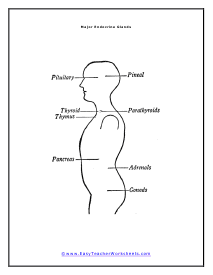

You're Getting on My Nerves! Short Answer Questions
Your nervous system is made up of your brain, the spinal cord and a large branching network of nerves that spread out from the spinal cord.


You're Getting on My Nerves! Short Answer Questions
Explain how signals travel back and forth between the brain and muscles so that the muscles move properly.


Otto, the O2 Molecule
Otto was gently tickled and cleaned of dust and dirt by cilia, the hairs inside your nose and then he passed through the pharynx (throat).

Otto, the O2 Molecule Multiple Choice Questions
Which part of the respiratory organs is strengthened by cartilage?

Otto, the O2 Molecule Short Answer Questions
A bronchial tube and all the bronchioles inside a lung are called a bronchial tree. Explain why this is a good metaphor.


Do You Remember Potty Training?
The liquid that you pee is called urine. Your body is constantly making urine but instead of getting rid of it as it's produced, urine is stored in a flexible sac in your lower abdomen called the bladder.


Excretory Short Answer Questions
Do some research and find out what the recommended amount of water to drink every day is.
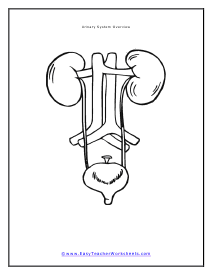



Your Skeleton Gives You Shape
Your skeleton is the framework of your body. The skeleton provides structural strength so you can sit, stand and walk plus some parts of your skeleton are designed to protect important organs.


Skeleton Short Answer Questions
You and your grandfather each break a leg in a skiing accident. Whose leg will probably heal faster and why?


Side View of Human Skeleton
Put your hand up in there. All the major parts are already labelled for you, but you can go into further detail.

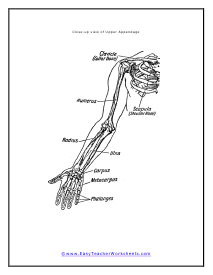
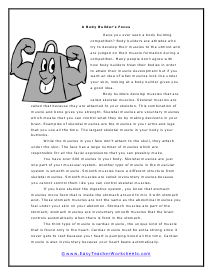
A Body Builder's Focus
Body builders are athletes who try to develop their muscles to the utmost and are judged on their muscle formation during a competition.
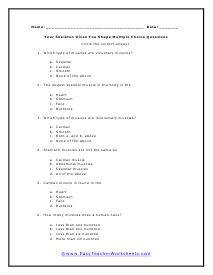
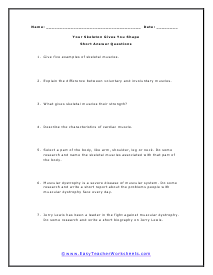
Muscle Short Answer Questions
Select a part of the body, like arm, shoulder, leg or neck. Do some research and name the skeletal muscles associated with that part of the body.
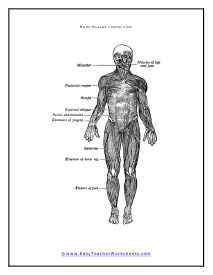

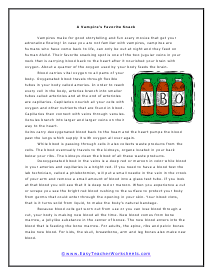
A Vampire's Favorite Snack
Blood carries vital oxygen to all parts of your body. Oxygenated blood travels through flexible tubes in your body called arteries. In order to reach every cell in the body, arteries branch into smaller tubes called arterioles and at the end of arterioles are capillaries.
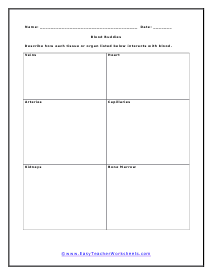
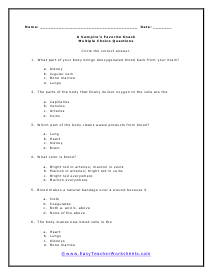
A Vampire's Favorite Snack Multiple Choice Questions
What part of your body brings deoxygenated blood back from your brain?

A Vampire's Favorite Snack Short Answer Questions
Explain how your body makes new blood to replace blood you lose from having a blood test or a cut (or a vampire bite!).

Red, White and Blue Working for You
The main organ of the circulatory system is the heart. The heart is a muscle that serves as the pump that moves or circulates the blood throughout the body.
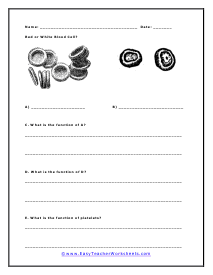
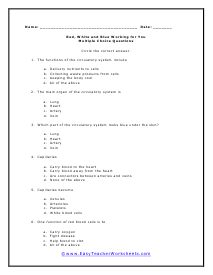
Red, White and Blue Working for You Multiple Choice Questions
Which part of the circulatory system looks blue under the skin?
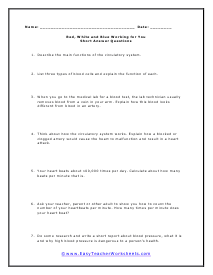
Circulatory Short Answer Questions
List three types of blood cells and explain the function of each.

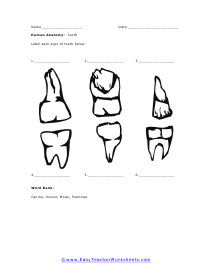
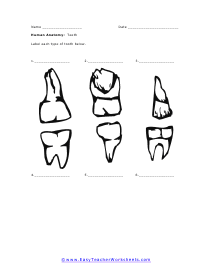
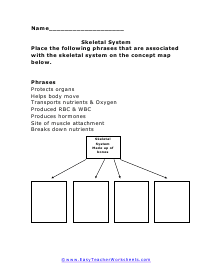
Skeletal System
Place the following phrases that are associated with the skeleton on the concept map below.
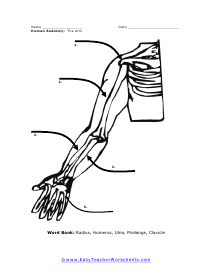
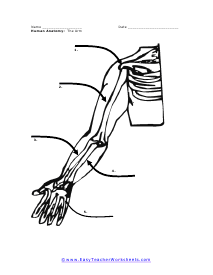

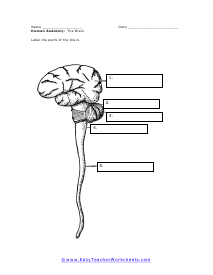
The Brain (No Bank)
If there were a bank it would be- Word Bank: Cerebellum, Spinal Cord, Cerebrum, Medulla, Midbrain
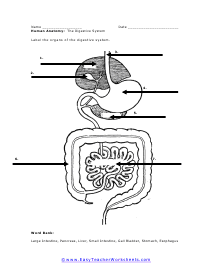
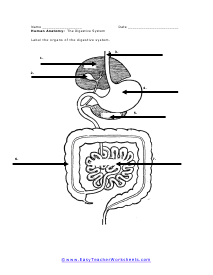
Digestive System (No Words)
Word Bank: Large Intestine, Pancreas, Liver, Small Intestine, Gall Bladder, Stomach, Esophagus
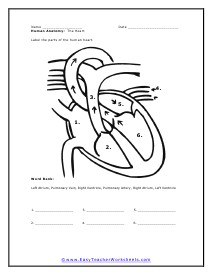
The Heart
Use the bank to label all of the parts of the heart correctly. Word Bank: Left Atrium, Pulmonary Vein, Right Ventricle, Pulmonary Artery, Right Atrium, Left Ventricle.


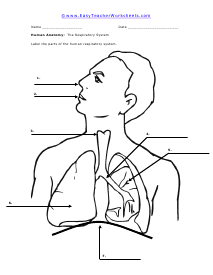


The Skeleton (Word Bank)
Word Bank: Fibula, Pelvis, Skull, Humerus, Sternum, Femur, Rib, Tibia, Rib, Vertebra
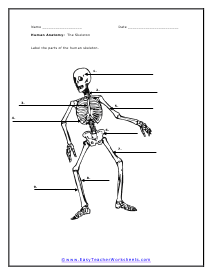

What are the Jobs of the Digestive Organs?
Label the liver, esophagus, large intestine, mouth, small intestine, gallbladder, pancreas, stomach, anus and appendix.

More Digestion
Label the organs that help with the chemical and physical changes of fat. Color these organs green.
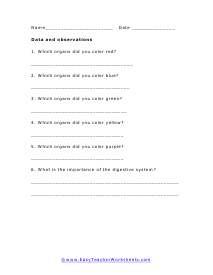
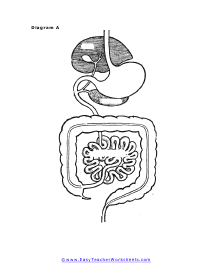

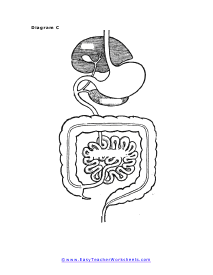
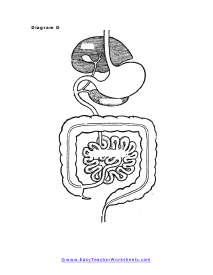
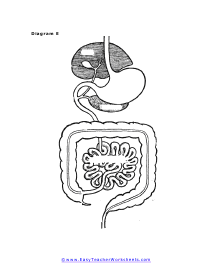
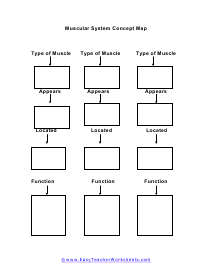

The Skeletal System
The term skeletal system refers collectively to all the bones, tendons, ligaments, and cartilage in a body. Tendons attach bones to muscles. Ligaments attach bones to other bones.


The Muscular System
All of the muscles in the human body are known collectively as the muscular system. There are more than 650 muscles in the human body. Muscles are found underneath of our skin, in some organs, and wrapped around all of our bones.

QUESTIONS: The Muscular System
Muscles are what enable the human body to move. Cardiac muscles, which are the ones in our heart, perform their function without us having to consciously tell them to do it.

The Cardiovascular System
Collectively, the heart, blood, and blood vessels make up the body's cardiovascular system. Blood picks up nutrients from the food we eat and oxygen from our lungs and carries those things to individual cells, where they are put to use.

QUESTIONS: The Cardiovascular System
The heart is located in the left side of your chest, inside of your rib cage. The heart is composed largely of muscle that expands and contracts to pump blood through the body.

The Digestive System
Our bodies use the food we eat for maintenance and construction, as well as to provide us with energy to do the things we do. However, the chemical energy that is stored in foods isn't accessible to the body in the form that we eat it. Before we can use the energy that is stored in the chemical bonds of our foods to power our bodies, we need to put some energy into those foods in order to convert them into a form our bodies can use.

QUESTIONS: The Digestive System
What is the name of the flap the keeps food from getting into our windpipe when we swallow?

The Nervous System
The brain, the spinal cord, and the nerve pathways all over the body are collectively called the nervous system. There are two parts to the nervous system. The central nervous system consists of the brain and the spinal cord. The peripheral nervous system are all the rest of the nerves located everywhere else.

QUESTIONS: The Nervous System
The peripheral nervous system includes two main sets of nerves. The autonomous nervous system works without us having to think about what is happening.

The Respiratory System
The respiratory system in the human body is responsible for bringing oxygen into the body and expelling carbon dioxide out of the body.

QUESTIONS: The Respiratory System
The nose is not just a place for air to come into the body. Nasal cavities contain both hair and mucus that filter dust and other particles out of the air so that these things don't get into our lungs.

The Endocrine System
The endocrine system is a group of glands in the human body that produce hormones. Hormones are chemicals that carry information and instructions between cells.

QUESTIONS: The Endocrine System
Which of the following is part of both the endocrine and digestive systems?

The Urinary System
When you eat, your digestive system breaks down the food into chemicals that your body can use for energy. This process produces both solid and liquid waste.

QUESTIONS: The Urinary System
When blood passes through the kidneys, water, protein, glucose, and other nutrients return to the bloodstream, while the waste is filtered out. This waste is in the form of urine, and it contains water, urea (waste resulting from the breakdown of proteins), urochrome (a pigmented blood product that colors urine yellow), salts, creatinine (waste resulting from the normal breakdown of muscle), byproducts of bile from the liver, and ammonia.

The Immune System
The immune system is the body's defense system against disease. The main organs making up the immune system are the spleen, lymph nodes, thymus, and bone marrow.

QUESTIONS: The Immune System
Proper immune function requires that the immune system know which cells to attack and which to leave alone. Specific antigens require specific antibodies, so antibodies only attack the cells they are supposed to attack and leave other cells alone.

The Integumentary System
Skin, hair, nails, and exocrine glands are collectively known as the integumentary system. Exocrine glands are glands that create and release substances through the skin, rather than through the blood.

What Are the Systems of the Human Body?
Our bodies are super cool! There are so many things going on in it that we still don't fully understand to this day. The mouth produces nearly one liter of saliva every day. Did you know that you shed nearly ten pounds of skin cells every year? In your lifetime, your heart will beat just about three billion (with a B) times. Some more numbers for you... The human body is made up of two-hundred and six bones working in concert with your three-hundred and twenty pairs of muscles. The top half of the body, the head, houses the control center organ of the body called the brain. The center part of the body is often referred to as the core and houses most major organ systems. The arms and legs that build off of the core are needed for movement and doing work.
A human body, like a machine, is made of numerous structures that work together to perform a specific function. These structures are categorized as cells, tissues, organs, and organ systems.
The systems of the human body include the digestive, nervous, and other major structures that work interdependently to ensure proper functioning. Each system is an organization of various organs that function as a unit to sustain life.
The Digestive System
Also known as the gastrointestinal system (GI), the digestive system is composed of the following:
- Esophagus
- Stomach
- Duodenum
- Intestines
These organs work together to ensure food is broken down chemically for absorption into the bloodstream. The blood transports the absorbed food to the cells for conversion into the energy we use for everyday activities.
It also eliminates undigested food in the form of fecal matter.
The Cardiovascular/Circulatory System
The circulatory system is the channel through which oxygen, nutrients, hormones, and other essential substances are distributed throughout the body. Distribution is achieved by the blood, which is pumped through the blood vessels by the heart.
Consequently, it is responsible for removing waste products from body cells.
The Respiratory System
Cells require oxygen for energy production, without which the body will die within minutes. The respiratory system ensures the intake of oxygen (inhalation) and diffusion into the bloodstream for conversion into energy. It also ensures the removal of carbon dioxide from the body (exhalation).
The organs responsible for these functions are the following:
- Pharynx (windpipe)
- Lungs
- Bronchi
- Air sacs
The Reproductive System
It is responsible for the creation of offspring in humans via sexual reproduction. The reproductive organs in males and females differ. Besides the production of sex cells, as in males, the female reproductive organs ensure the growth and development of the offspring.
It's through reproduction that the continuity of the human species is guaranteed.
The Nervous System
We perceive sensations and emotions, and respond to environmental changes, thanks to our nervous system. It transmits signals from the brain to the rest of the body and vice versa through a network of nerves attached to the spinal cord.
The Excretory/Urinary System
This is the body's drainage mechanism, and it works to filter blood and remove waste metabolic products in the form of urine.
The mechanism consists of:
- Kidneys
- Ureter
- Urethra
- Urinary bladder
It's also responsible for controlling the blood's water and salt concentration and maintaining its PH at normal.
The Musculoskeletal System
This is an organization of bones, muscles, and tendons that provide the body with its general framework. It's responsible for support, protection of vital organs, body posture, and movement. The bones manufacture blood cells and store essential minerals like calcium.
The Integumentary System
Also called the exocrine system, the integumentary system works to protect our inner organs from the environment. It consists of:
- Skin
- Hair
- Nails
It also plays a significant role in regulating water and body temperature, excretion of sweat, and vitamin D synthesis.
The Endocrine System
It is composed of various glands that secrete hormones that control most body functions.
The hormones are responsible for processes like:
- The menstrual cycle
- Growth
- Blood sugar regulation
- Cell metabolism and other similar processes
The Immune and Lymphatic Systems
These two systems complement each other to provide immunity to the body.
The lymphatic system plays a role in the production and cleansing of the lymph, a fluid that houses the immune system's lymphocytes, otherwise known as white blood cells. It also drains excess lymph fluid from tissues, returning It to the circulatory system.
On the other hand, the immune system comprises:
- White blood cells
- Antibodies
- Bone marrow
- Spleen
- Thymus
These all work with the lymphatic system to fight infections.
In Summary
The human body is composed of a network of systems that are composed of organs and tissues that work as a unit to execute a complex function. The functionality of these systems is vital for the sustainability of human life.


